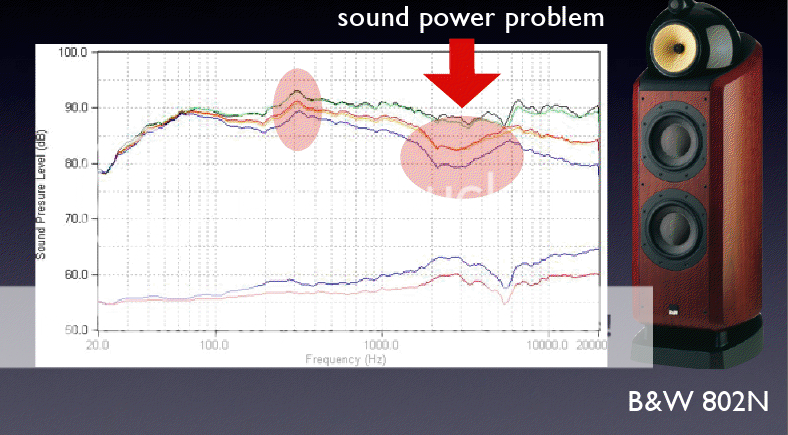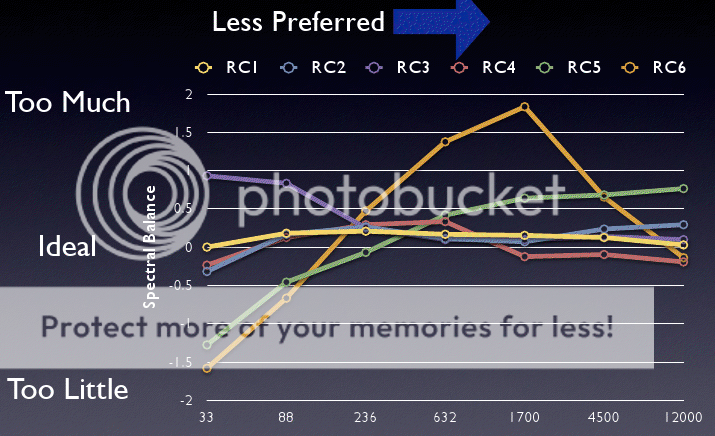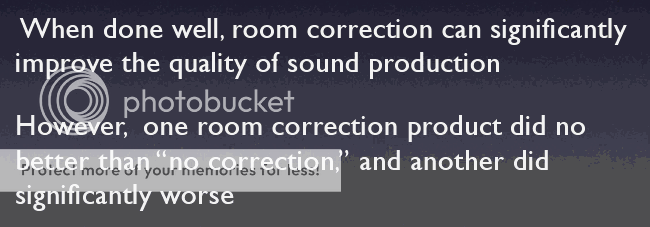Let's assume, for the sake of argument, a "medium" size room - perhaps a bit smaller than my room in New Orleans. Say 13 feet wide by 20 feet deep, with mancave privileges. I don't think it would be impractical to set speakers up 6 feet into the room, and thus have a > 10 ms bipole/dipole reflection path off the wall behind them. The distance of course would be much shorter to the side walls, but the combination of setup geometry and controlled directivity keeps the magnitude of any early-arrival sidewall reflection from the back of the speaker quite low in amplitude.
Edit: What I'm really most interested in is your assessment of the scenario I described in post 1268, assuming one can achieve the required setup geometry.
Duke
I mentioned in an earlier post, I have 14 ms of delay from the dipole back wave in a room of only 8 feet wide and 19 feet long. I don't think it's an impractical set-up at all. The speakers take up very little room because they can be close to the side walls (in fact this keeps the stereo triangle sufficiently large in this case).
Its not just the back wall, its the side walls as well. If you are "assuming" that a dipole will not have any side wall reflections then I would disagree. I believe that all back wall (behind the speakers) reflections are bad (as does Toole) and that the reverberant energy needs to come from the sides and the rear. This means that dipole or bipole speakers are not a good choice because they have too much back wall energy, unless you absorb it, in which case all this rear facing energy is wasted.
I believe that all back wall (behind the speakers) reflections are bad (as does Toole) and that the reverberant energy needs to come from the sides and the rear.
What is the basis behind this belief?
Its not just the back wall, its the side walls as well. If you are "assuming" that a dipole will not have any side wall reflections then I would disagree. I believe that all back wall (behind the speakers) reflections are bad (as does Toole) and that the reverberant energy needs to come from the sides and the rear. This means that dipole or bipole speakers are not a good choice because they have too much back wall energy, unless you absorb it, in which case all this rear facing energy is wasted.
With bipolar speakers toed-in 45 degrees, the energy from the rear-facing drivers reflects off the back wall and off the side walls. But the primary paths for these reflections to reach the listening area can easily impose > 10 ms time delay, with much of that energy arriving as lateral reflections. With good pattern control, the energy that "leaks" around the far side of the speaker and arrives as a < 10 ms reflection will be well down in amplitidue, and is fairly easy to spot-treat with absorption.
I agree that early-arriving specular reflections from behind the speakers are bad, but I'm not sure about late-arriving, > 10 ms (and ideally fairly diffuse) reflections. I think that, with proper setup geometry, the benefit from the additional late-arrival energy that starts out reflecting off the wall(s) behind the speakers outweighs, but have no proof. However if one's speakers aren't too difficult to move, this is the sort of thing that can be experimented with in mono at little or no cost, to a reasonable first approximation at least.
By the way, thanks for responding to me, Earl. I know you disagree with this approach so I appreciate your taking the time.
Last edited:
I like this graph/study from Dr. Olive about preferred room response curves:


Fixing the power response in the treble seems to have helped as did just 'fixing' it and the bass for just one location.
Thoughts?
Dan
I believe he was looking at DSP room EQ units. If I remember the top two curves are the Harman unit but one is set for best 6 seat average and the second set for best single seat average. The other units were various competitors including Tact and Audesey?
All have some arbitrary down tilting "room curve", as they must, since they are EQing the steady state (room) curve. Not the best approach.
The 6 seat averages and the center seat average are pretty close for upper frequencies and vary a bit for low frequencies. This in spite of Audesey spreading the flasehood that they can lessen the variation between seats (not possible with EQ to a single speaker).
I'm not sure there is anything to do with power response here.
David S.
What is the basis behind this belief?
Reflections from the area arround the speakers all tend to degrade the image and do little to nothing to add to spaciousness. It is well know that spaciousness requires lateral reflections to the sides and rear. Forward reflections do not add to spaciousness.
I think this addresses Duke's comments as well.
I did wonder about the downwards slope, and whether it was a steady state room response...All have some arbitrary down tilting "room curve", as they must, since they are EQing the steady state (room) curve. Not the best approach.
What baffles me is why commercial manufacturers continue to make "automatic room EQ" systems, both built into AV receivers and stand alone that are based either entirely or largely on steady state 1/n octave pink noise RTA measurements taken at the listening position, when all the acoustical research says that this is fundamentally the wrong way to measure the response.
The built in Room EQ mode of my DEQ2496 is just one of many examples of a naive, pink noise RTA based steady-state Auto EQ system that will adjust a narrow band graphic EQ in a futile attempt to "flatten" the response. (To be fair we're talking about a 2003 era piece of equipment that isn't intended for home / small room use)
The end result is that it is the steady state response that is "flattened" not the direct field, (or a slight downwards "room curve" tilt if selected) as well as (depending on maximum slope setting) very steep slopes being applied between adjacent EQ bands, resulting in very odd sound indeed. (Imaging lots of narrow EQ bands being alternatively pushed up and down several dB in a futile attempt to correct narrow band comb filtering)
I've tried it many times and it always makes the sound worse, often much worse. Years ago I didn't understand why, but more recently I do, now that I understand it's measuring the wrong thing.
All of the auto-EQ systems I've heard have always made the result worse, unless the speaker itself was very non-flat to start with. If it was a good speaker with flat on axis response to begin with the result is always worse.
About the only way I could ever see an automatic Room EQ system that sort of works, is if they were to adopt a fully sliding window integration system as you were describing earlier, (so that it's EQ'ing the direct field at high frequencies) as well as a bit of "intelligence" about what to correct and what not to attempt to correct. (Don't try to correct notches that are a result of comb filtering, treat above and below the Schroeder frequency differently etc)
Even then I have my doubts about the ability to do it in any automated fashion.
Gimmick to sell equipment when people should be putting the money towards speakers with a better un-corrected response ?
Last edited:
I am a bit lost in this topic, can you give me some references, I'm mostly interested.
it is all over the thread, specifically I meant Dr Toole and studies that He referred to in His book
just google for Toole, reflections and so on
Close, the best is for 1 seat EQing, 2nd was for 6 seat average.I believe he was looking at DSP room EQ units. If I remember the top two curves are the Harman unit but one is set for best 6 seat average and the second set for best single seat average. The other units were various competitors including Tact and Audesey?
Maybe, maybe not... These EQs have worked better for me than any other method. They beat the unEQed sound in the study as well. Doesn't mean they are a substitute for good speakers or room treatment of course.All have some arbitrary down tilting "room curve", as they must, since they are EQing the steady state (room) curve. Not the best approach.
Audyssey's claims... Not touching them. I'm going to go through some slides here with power response in mind:The 6 seat averages and the center seat average are pretty close for upper frequencies and vary a bit for low frequencies. This in spite of Audesey spreading the flasehood that they can lessen the variation between seats (not possible with EQ to a single speaker).
I'm not sure there is anything to do with power response here.
David S.



above is for one seat




There was a nice sub in there as well.
I don't see how Harman could be 'fixing' the power response directly, but it looks like that's their aim and it seems to work. I'd rather start with 'right', but if you need to buy esoteric speakers for whatever reason, looks like they can still be improved in their perceived balance. The top three fill in the hole on the power response. The top one also has the best bass response--that could be the biggest part of it, but it would be hard to argue that the power correction didn't play a role. Wish he would have kept the colors the same throughout. The software I use is the same as the top.
My 6 seat curve ended up looking like this:

unsmoothed

smoothed
vs:

My subs are not as good as the one in the study.
Dan
Last edited:
Gimmick to sell equipment when people should be putting the money towards speakers with a better un-corrected response ?
Audiophiles will never cease to love cool looking boxes that they can play with. Making things sound better is fine, even if it doesn't, but fun to play with is the key.
The fact is that electronics can never correct acoustical problems. They MAY be able to improve very bad situations, but they will never make a truely great system. A truely great design has no use for these "boxes".
The fact is that electronics can never correct acoustical problems. They MAY be able to improve very bad situations, but they will never make a truely great system. A truely great design has no use for these "boxes".
This surprises me. Are you thinking about equalization here? I think the design rationale behind my system is quite sound (pun intended) and some DSP certainly helped, especially in the bass range of course.
Its not just the back wall, its the side walls as well. If you are "assuming" that a dipole will not have any side wall reflections then I would disagree. I believe that all back wall (behind the speakers) reflections are bad (as does Toole) and that the reverberant energy needs to come from the sides and the rear. This means that dipole or bipole speakers are not a good choice because they have too much back wall energy, unless you absorb it, in which case all this rear facing energy is wasted.
I'm not assuming a dipole will not have side wall reflections; they will be lower in level than with typical speakers, especially in the midrange.
Because of the toe in, the back wave is reflected via three walls (side, rear, opposite side). By the way, in figure 6.7 in Sound Reproduction, one can see that the detection threshold for a reflection coincident at the loudspeaker is about 15 dB higher the threshold for a lateral reflection. With sufficient delay, comb filtering will not be a real problem for such reflections.
Propagation delay relative to the direct sound is usually much higher for rear wall reflections than for side wall reflections, so if one would have to "tolerate" any, I would choose the rear wall for practical reasons.
Last edited:
I did wonder about the downwards slope, and whether it was a steady state room response...
What baffles me is why commercial manufacturers continue to make "automatic room EQ" systems, both built into AV receivers and stand alone that are based either entirely or largely on steady state 1/n octave pink noise RTA measurements taken at the listening position, when all the acoustical research says that this is fundamentally the wrong way to measure the response.
Kudos to you for understanding the issue. I've been talking about this for a while now and nobody other than Tony Grimani (fromerly of THX) has been on the same page.
I was involved in the Snell RCS1000, which begat the Tact, which begat the Lyngdorf and they all had the same issue. I sat through several Audesey demos where they let the computer create the perfect EQ curve, had a listen, didn't like it, massaged the "house curve" and let the computer have another go at it. After 5 go-rounds of that you think "perfect automatic EQ?"
Absolutely, for automatic EQ to work the 1st step, measurement, must be done in a way that mimics the way hearing works. Without that the process can never be reliable. It may generally be an improvement over no EQ, but it won't always work because we are measuring the wrong thing. The cinema analogy is the inconsistency of sound in theaters all EQed to the same X curve.
From what I've seen most of these products are designed by hotshot DSP guys with, unfortunately, very little knowledge of psychoacoustics.
David S.
The fact is that electronics can never correct acoustical problems. They MAY be able to improve very bad situations, but they will never make a truely great system. A truely great design has no use for these "boxes".
The very quoted Dr Geddes is right with his perspective : He is searching an all around solution, a commercial one, that fits well in most rooms. This is a very difficult task.
It's a different problem for the individual DIYer, that can comparatively take it easy, play with his EQ and correct his mistakes little by little, could it be under his own erroneous assumptions.
If some people are harmed by the commercial background, or the "horse in the race", they have to realize that without commercial expectations, we would have almost no HiFi to speak about, and even no music to listen to.
The Audissey slides are nice, must be the steady state, because when measured like this the 1dB fall is also my preferred.
Dan, the two REW shots are your system room response ? If yes, I have almost the same. Probably a possible human preference constant (see the once dedicated thread).
This surprises me. Are you thinking about equalization here? I think the design rationale behind my system is quite sound (pun intended) and some DSP certainly helped, especially in the bass range of course.
EQ cannot cure a bad polar response, for example. There are some things it can fix and others it cannot. Let's say that you have a hole at a certain spot. If you EQ this hole then you have most likely made the situation worse, because you have turned a relatively benign "hole" at one small location into a giant, and audible, boost in the power response. When you understand and start to think of the 3D nature of acoustics then you will understyand why a 1D electrical solution has no hope of frixing acoustic problems.
The LF situation is quite different of course, because the wavelengths are so long it basically IS a 1D problem. Not so when the wavelengths get to be the size of the speaker.
If you look at a polar map, what can be corrected and what cannot is immediately obvious. Only things that occur in a line parallel to the angular axis (i.e. independent of angle) can be corrected. These are the exception, not the norm.
I am not so sure Dave about the lack of psychoacoustic knowledge by these guys though I think you are correct that their implementation isn't optimal. I think it's designed to be end user proof as well as improved. I could well be wrong. Some of the 'pro' room correction stuff the the JBL MSC-1 look to be a better option if I understand the thing correctly.
You have to admit that power response 'fix' is thought provoking--well I guess you don't.
Dan
You have to admit that power response 'fix' is thought provoking--well I guess you don't.
Dan
MLSSA had an "Adaptive Window" type thing (and I've only read about this) that puts out a curve that is consistent with how we hear, ie, short listening window for high frequencies and increasingly long windows as the frequency becomes lower. D'Appolito's book on loudspeaker measurement talks about this (a fantastic book, btw).
It should not be too hard to do... maybe we can push the ARTA guys to implement it in their already wonderful software.
It should not be too hard to do... maybe we can push the ARTA guys to implement it in their already wonderful software.
- Status
- This old topic is closed. If you want to reopen this topic, contact a moderator using the "Report Post" button.
- Home
- Loudspeakers
- Multi-Way
- What is the ideal directivity pattern for stereo speakers?